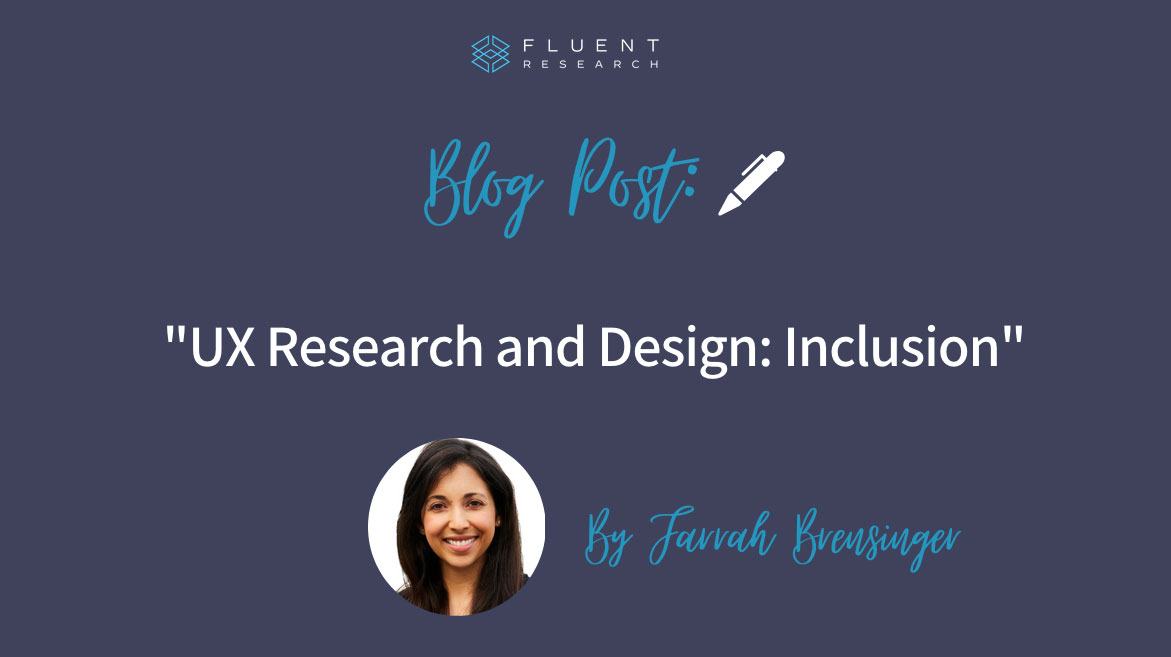
31 Mar UX Research and Design: Inclusion
Last month, I attended the Critical UX: Challenging the Dogma of UX event hosted by HmntyCntrd. At this virtual symposium, academics, researchers and designers from around the world gathered to examine some of the prevailing credos that have emerged in the UX field. What ensued were rich discussions that went beyond buzzwords and unpacked inclusivity, universality, and individualism in UX research and design. At the end, I walked away with a deeper understanding of how to better honor my research participants’ lived experiences.
Three points especially resonated:
The value of wholesale inclusion
It is possible for those involved in research to take a narrow view of inclusion; making it primarily about whether someone from a historically underrepresented group is included in a sample. While representation in a sample is a good step forward, what if inclusion was more than just ensuring that those from underrepresented groups were included in a research?
Panelists at Critical UX asked the audience to scrutinize whether the entirety of their research processes considers the many facets of inclusion. Particularly, they asked those in attendance to think about recruitment processes, research methodologies, and whether built solutions are serving the needs of marginalized groups included in research. Panelist Alex Haargaard mentioned how recruiting people in wheelchairs, for example, could be one part of the inclusion process, but to be more comprehensively inclusive requires more thought into different elements of participation for people in wheelchairs. In practice, this could mean examining a research facility for accessibility or ensuring that tables in a testing room are at a wheelchair friendly height. Comprehensive inclusivity may also mean consistently engaging with wheelchair users through the many different stages of the product design process, so that early prototypes, built solutions, launched products, etc. can be tested with them.
The UX researcher is positioned to advance inclusion by creating research processes that are accessible. And though it may require more effort to sustain their involvement due to systemic barriers, a UX researcher can advocate for underrepresented participants to have a consistent presence in the design process, from product inception through continuous iteration cycles. I am freshly challenged to consider how my research process, from start to finish, can better include marginalized groups.
The importance of making space for different perspectives
In data collection, it’s possible to inadvertently shut out insights from people who have idiosyncratic ways of perceiving the world. This can affect the quality of data and the way it is ultimately used. It can therefore be helpful to proactively invite participants to volunteer their unfiltered perspectives about what matters to them in their daily lives. To illustrate this, panelist Dr. Madhuri Karak recounted a community mapping project with Asian villagers. The research participants insisted on faithful delineations of their places of interest. What resulted was a multi-sensory map that tracked orangutan breeding grounds, riverside resting places, trees with springtime songbirds, and other landmarks that may have been otherwise foregone.
Thinking on Dr. Karak’s example, I could see myself having expected the Asian villagers to map street names, schools, meeting halls, and other similar places when community mapping. Such expectations would reflect my own ideas of what is noteworthy in a community, but would have been an incomplete reflection of the research participants’ ideas of what is noteworthy.
At Fluent, our exploratory research spans the globe and we regularly visit participants’ homes, schools, workplaces, and communities to see their lives in action. Within UX research, it is essential to explore how participants actually perceive the world around them and understand how technological products integrate with their daily lives. For this reason, it’s important to make sufficient space for participants to offer their own perspectives. For me, this may require loosening my expectations for how participants “should” define aspects of their own lives in favor of how they actually define their lives. This may take on even greater importance in cross-cultural settings where research participants may have different worldviews.
The necessity of UX informing decisions about scale
As engineers and designers create technologies for education, healthcare, and other institutional spaces, many of them think about getting their products into as many hands as possible. Panelists had the audience consider the upsides and downsides to scaling up a product’s distribution, and the role that UX research can play in helping make decisions about scale. While some problems can be solved by blanket solutions that serve a broad array of people, other problems may require solutions that are more tailored. Moreover, as automation and AI become a larger part of technological design, questions of human-computer interaction enter the forefront in new ways. To illustrate this, panelist Andrea Ngan raised the question of “scaling health care” with automation, and how for patients, figuring out health care needs through machine interactions may be less appealing than working with other human beings. In cases where users have strong sentiments about a product, the success of a product, no matter how good it is, can hang in the balance.
Ngan’s example sheds light on instances where UX research can contribute to organizational decisions around scale and user adoption. User research can help identify whether a more universal solution can actually meet the differentiated needs of users, or whether a more customized, small-scale approach is more appropriate. UX research can also help understand user needs and sentiments, helping to determine the appeal of a product or service and whether there might be resistance to it. This line of conversation pushes me to think about the myriad of ways user-centric research can impact product design conversations, including some of the bigger questions along the product design roadmap.
Overall, the Critical UX: The Dogmas of UX strengthened who I am as a researcher by inviting me to take a closer look at my own research processes. I am grateful to have spent an afternoon listening to UX leaders who are entertaining the big questions in earnest. Furthermore, I’m eager to put what I’ve learned into practice to better elevate the voices and stories of participants I work with at Fluent.
By Senior User Experience Researcher Farrah Brensinger


